Investigating Music-Based Activities, Productivity, and QWL at Work
VerifiedAdded on 2022/10/15
|17
|4348
|19
Literature Review
AI Summary
This literature review explores the impact of music-based activities on employee productivity and their perceived quality of working life (QWL). It delves into key concepts such as QWL, job satisfaction, music-based activities, stress, and productivity, defining each and examining their interrelationships. The review highlights how a favorable QWL can lead to increased productivity and customer loyalty, while unfavorable conditions can result in stress and decreased performance. Job satisfaction is discussed as a crucial element for employee well-being and productivity, with factors like promotions, pay, and colleague relationships playing significant roles. The review also explores how music can alleviate work-related stress and improve mood, ultimately increasing a worker's quality of work and productivity. Finally, it addresses workplace stress, its causes, and its impact on employee health and productivity, emphasizing the importance of managing stress to maintain a positive and productive work environment.
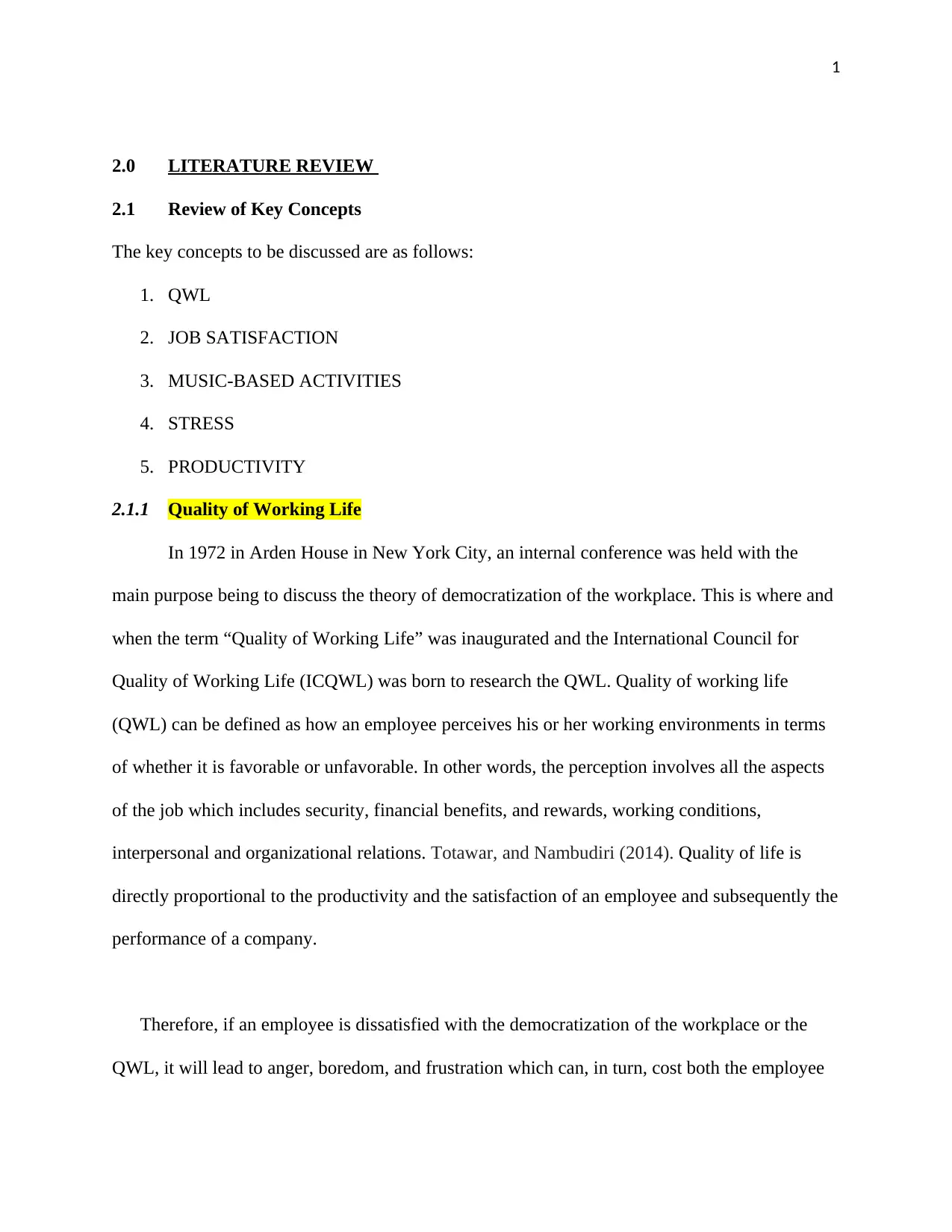
1
2.0 LITERATURE REVIEW
2.1 Review of Key Concepts
The key concepts to be discussed are as follows:
1. QWL
2. JOB SATISFACTION
3. MUSIC-BASED ACTIVITIES
4. STRESS
5. PRODUCTIVITY
2.1.1 Quality of Working Life
In 1972 in Arden House in New York City, an internal conference was held with the
main purpose being to discuss the theory of democratization of the workplace. This is where and
when the term “Quality of Working Life” was inaugurated and the International Council for
Quality of Working Life (ICQWL) was born to research the QWL. Quality of working life
(QWL) can be defined as how an employee perceives his or her working environments in terms
of whether it is favorable or unfavorable. In other words, the perception involves all the aspects
of the job which includes security, financial benefits, and rewards, working conditions,
interpersonal and organizational relations. Totawar, and Nambudiri (2014). Quality of life is
directly proportional to the productivity and the satisfaction of an employee and subsequently the
performance of a company.
Therefore, if an employee is dissatisfied with the democratization of the workplace or the
QWL, it will lead to anger, boredom, and frustration which can, in turn, cost both the employee
2.0 LITERATURE REVIEW
2.1 Review of Key Concepts
The key concepts to be discussed are as follows:
1. QWL
2. JOB SATISFACTION
3. MUSIC-BASED ACTIVITIES
4. STRESS
5. PRODUCTIVITY
2.1.1 Quality of Working Life
In 1972 in Arden House in New York City, an internal conference was held with the
main purpose being to discuss the theory of democratization of the workplace. This is where and
when the term “Quality of Working Life” was inaugurated and the International Council for
Quality of Working Life (ICQWL) was born to research the QWL. Quality of working life
(QWL) can be defined as how an employee perceives his or her working environments in terms
of whether it is favorable or unfavorable. In other words, the perception involves all the aspects
of the job which includes security, financial benefits, and rewards, working conditions,
interpersonal and organizational relations. Totawar, and Nambudiri (2014). Quality of life is
directly proportional to the productivity and the satisfaction of an employee and subsequently the
performance of a company.
Therefore, if an employee is dissatisfied with the democratization of the workplace or the
QWL, it will lead to anger, boredom, and frustration which can, in turn, cost both the employee
Paraphrase This Document
Need a fresh take? Get an instant paraphrase of this document with our AI Paraphraser
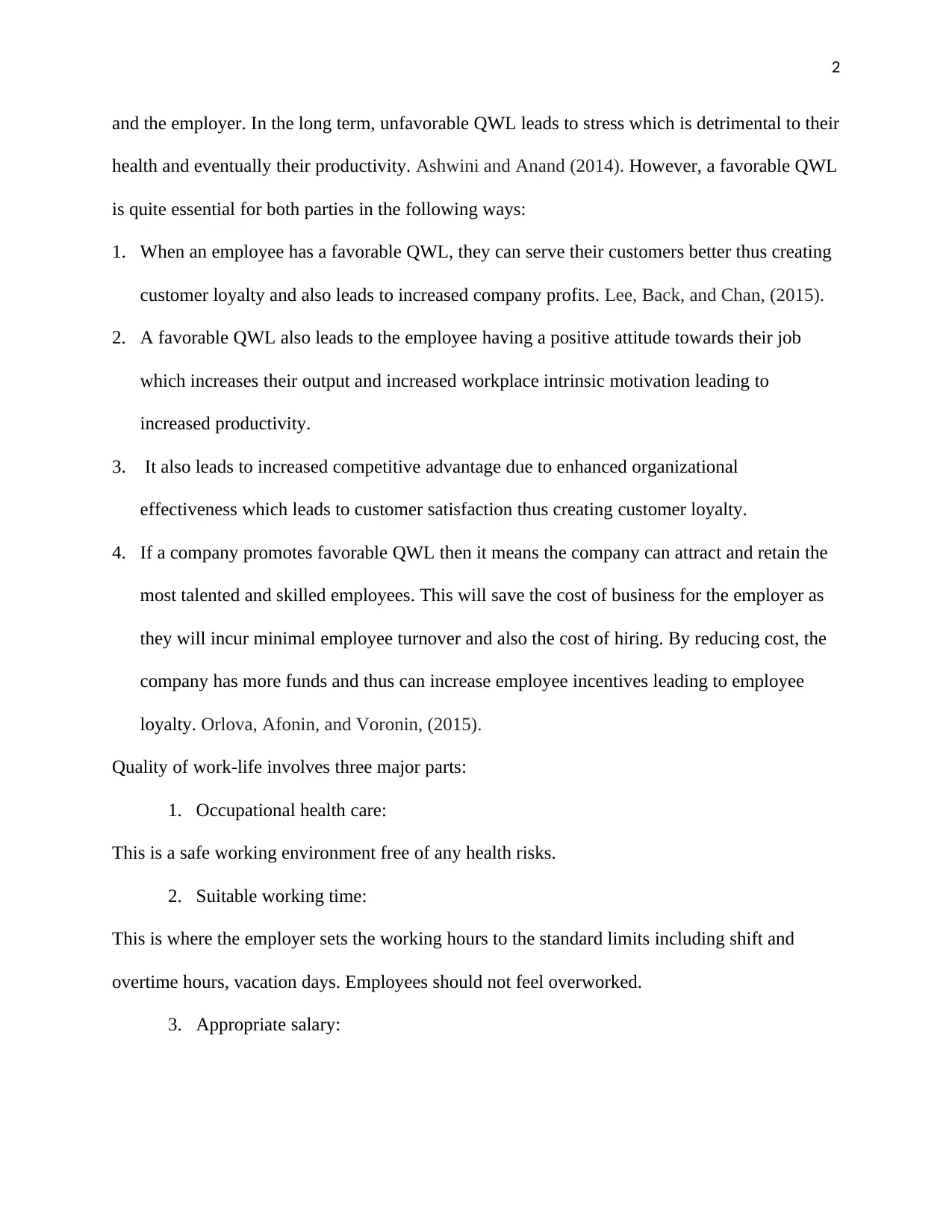
2
and the employer. In the long term, unfavorable QWL leads to stress which is detrimental to their
health and eventually their productivity. Ashwini and Anand (2014). However, a favorable QWL
is quite essential for both parties in the following ways:
1. When an employee has a favorable QWL, they can serve their customers better thus creating
customer loyalty and also leads to increased company profits. Lee, Back, and Chan, (2015).
2. A favorable QWL also leads to the employee having a positive attitude towards their job
which increases their output and increased workplace intrinsic motivation leading to
increased productivity.
3. It also leads to increased competitive advantage due to enhanced organizational
effectiveness which leads to customer satisfaction thus creating customer loyalty.
4. If a company promotes favorable QWL then it means the company can attract and retain the
most talented and skilled employees. This will save the cost of business for the employer as
they will incur minimal employee turnover and also the cost of hiring. By reducing cost, the
company has more funds and thus can increase employee incentives leading to employee
loyalty. Orlova, Afonin, and Voronin, (2015).
Quality of work-life involves three major parts:
1. Occupational health care:
This is a safe working environment free of any health risks.
2. Suitable working time:
This is where the employer sets the working hours to the standard limits including shift and
overtime hours, vacation days. Employees should not feel overworked.
3. Appropriate salary:
and the employer. In the long term, unfavorable QWL leads to stress which is detrimental to their
health and eventually their productivity. Ashwini and Anand (2014). However, a favorable QWL
is quite essential for both parties in the following ways:
1. When an employee has a favorable QWL, they can serve their customers better thus creating
customer loyalty and also leads to increased company profits. Lee, Back, and Chan, (2015).
2. A favorable QWL also leads to the employee having a positive attitude towards their job
which increases their output and increased workplace intrinsic motivation leading to
increased productivity.
3. It also leads to increased competitive advantage due to enhanced organizational
effectiveness which leads to customer satisfaction thus creating customer loyalty.
4. If a company promotes favorable QWL then it means the company can attract and retain the
most talented and skilled employees. This will save the cost of business for the employer as
they will incur minimal employee turnover and also the cost of hiring. By reducing cost, the
company has more funds and thus can increase employee incentives leading to employee
loyalty. Orlova, Afonin, and Voronin, (2015).
Quality of work-life involves three major parts:
1. Occupational health care:
This is a safe working environment free of any health risks.
2. Suitable working time:
This is where the employer sets the working hours to the standard limits including shift and
overtime hours, vacation days. Employees should not feel overworked.
3. Appropriate salary:
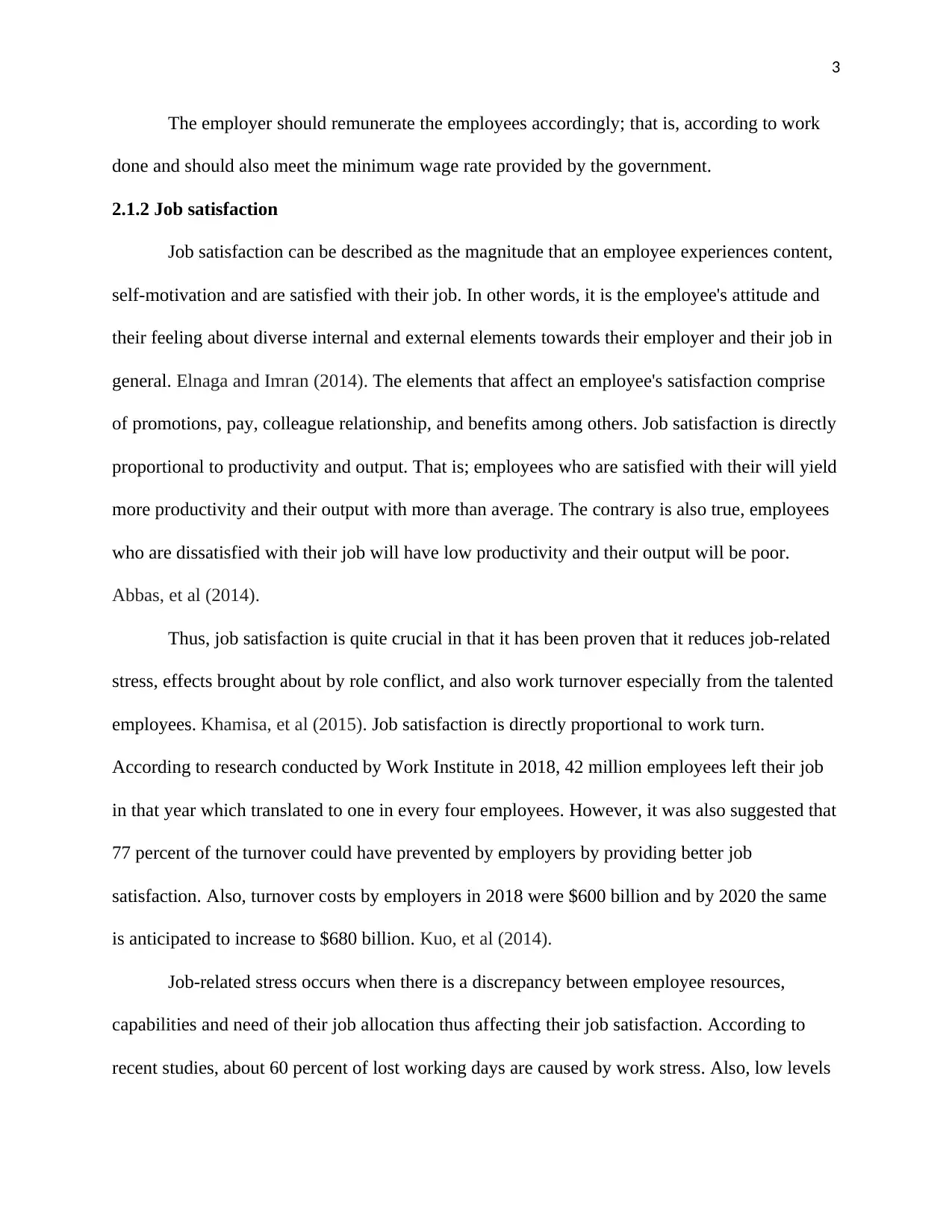
3
The employer should remunerate the employees accordingly; that is, according to work
done and should also meet the minimum wage rate provided by the government.
2.1.2 Job satisfaction
Job satisfaction can be described as the magnitude that an employee experiences content,
self-motivation and are satisfied with their job. In other words, it is the employee's attitude and
their feeling about diverse internal and external elements towards their employer and their job in
general. Elnaga and Imran (2014). The elements that affect an employee's satisfaction comprise
of promotions, pay, colleague relationship, and benefits among others. Job satisfaction is directly
proportional to productivity and output. That is; employees who are satisfied with their will yield
more productivity and their output with more than average. The contrary is also true, employees
who are dissatisfied with their job will have low productivity and their output will be poor.
Abbas, et al (2014).
Thus, job satisfaction is quite crucial in that it has been proven that it reduces job-related
stress, effects brought about by role conflict, and also work turnover especially from the talented
employees. Khamisa, et al (2015). Job satisfaction is directly proportional to work turn.
According to research conducted by Work Institute in 2018, 42 million employees left their job
in that year which translated to one in every four employees. However, it was also suggested that
77 percent of the turnover could have prevented by employers by providing better job
satisfaction. Also, turnover costs by employers in 2018 were $600 billion and by 2020 the same
is anticipated to increase to $680 billion. Kuo, et al (2014).
Job-related stress occurs when there is a discrepancy between employee resources,
capabilities and need of their job allocation thus affecting their job satisfaction. According to
recent studies, about 60 percent of lost working days are caused by work stress. Also, low levels
The employer should remunerate the employees accordingly; that is, according to work
done and should also meet the minimum wage rate provided by the government.
2.1.2 Job satisfaction
Job satisfaction can be described as the magnitude that an employee experiences content,
self-motivation and are satisfied with their job. In other words, it is the employee's attitude and
their feeling about diverse internal and external elements towards their employer and their job in
general. Elnaga and Imran (2014). The elements that affect an employee's satisfaction comprise
of promotions, pay, colleague relationship, and benefits among others. Job satisfaction is directly
proportional to productivity and output. That is; employees who are satisfied with their will yield
more productivity and their output with more than average. The contrary is also true, employees
who are dissatisfied with their job will have low productivity and their output will be poor.
Abbas, et al (2014).
Thus, job satisfaction is quite crucial in that it has been proven that it reduces job-related
stress, effects brought about by role conflict, and also work turnover especially from the talented
employees. Khamisa, et al (2015). Job satisfaction is directly proportional to work turn.
According to research conducted by Work Institute in 2018, 42 million employees left their job
in that year which translated to one in every four employees. However, it was also suggested that
77 percent of the turnover could have prevented by employers by providing better job
satisfaction. Also, turnover costs by employers in 2018 were $600 billion and by 2020 the same
is anticipated to increase to $680 billion. Kuo, et al (2014).
Job-related stress occurs when there is a discrepancy between employee resources,
capabilities and need of their job allocation thus affecting their job satisfaction. According to
recent studies, about 60 percent of lost working days are caused by work stress. Also, low levels
⊘ This is a preview!⊘
Do you want full access?
Subscribe today to unlock all pages.

Trusted by 1+ million students worldwide
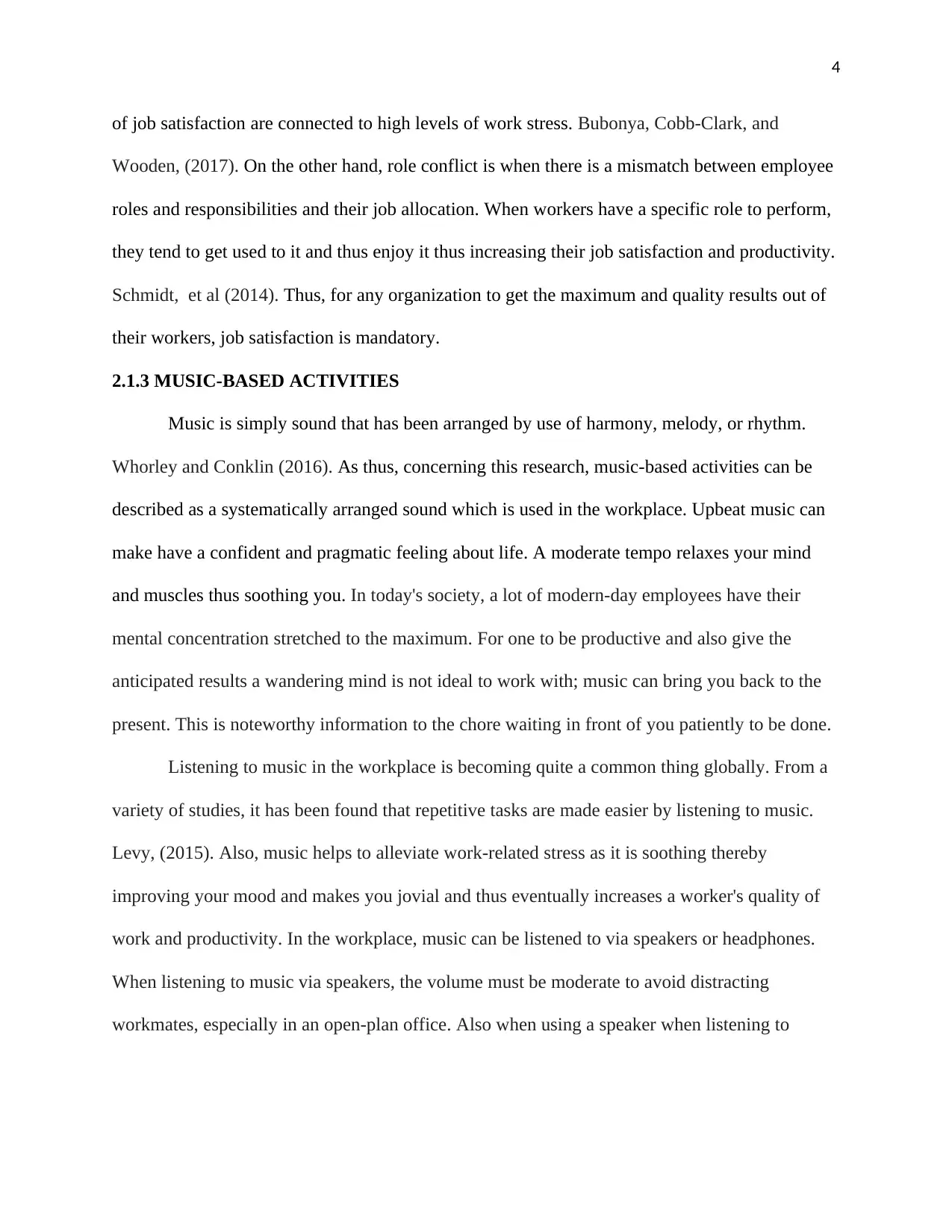
4
of job satisfaction are connected to high levels of work stress. Bubonya, Cobb-Clark, and
Wooden, (2017). On the other hand, role conflict is when there is a mismatch between employee
roles and responsibilities and their job allocation. When workers have a specific role to perform,
they tend to get used to it and thus enjoy it thus increasing their job satisfaction and productivity.
Schmidt, et al (2014). Thus, for any organization to get the maximum and quality results out of
their workers, job satisfaction is mandatory.
2.1.3 MUSIC-BASED ACTIVITIES
Music is simply sound that has been arranged by use of harmony, melody, or rhythm.
Whorley and Conklin (2016). As thus, concerning this research, music-based activities can be
described as a systematically arranged sound which is used in the workplace. Upbeat music can
make have a confident and pragmatic feeling about life. A moderate tempo relaxes your mind
and muscles thus soothing you. In today's society, a lot of modern-day employees have their
mental concentration stretched to the maximum. For one to be productive and also give the
anticipated results a wandering mind is not ideal to work with; music can bring you back to the
present. This is noteworthy information to the chore waiting in front of you patiently to be done.
Listening to music in the workplace is becoming quite a common thing globally. From a
variety of studies, it has been found that repetitive tasks are made easier by listening to music.
Levy, (2015). Also, music helps to alleviate work-related stress as it is soothing thereby
improving your mood and makes you jovial and thus eventually increases a worker's quality of
work and productivity. In the workplace, music can be listened to via speakers or headphones.
When listening to music via speakers, the volume must be moderate to avoid distracting
workmates, especially in an open-plan office. Also when using a speaker when listening to
of job satisfaction are connected to high levels of work stress. Bubonya, Cobb-Clark, and
Wooden, (2017). On the other hand, role conflict is when there is a mismatch between employee
roles and responsibilities and their job allocation. When workers have a specific role to perform,
they tend to get used to it and thus enjoy it thus increasing their job satisfaction and productivity.
Schmidt, et al (2014). Thus, for any organization to get the maximum and quality results out of
their workers, job satisfaction is mandatory.
2.1.3 MUSIC-BASED ACTIVITIES
Music is simply sound that has been arranged by use of harmony, melody, or rhythm.
Whorley and Conklin (2016). As thus, concerning this research, music-based activities can be
described as a systematically arranged sound which is used in the workplace. Upbeat music can
make have a confident and pragmatic feeling about life. A moderate tempo relaxes your mind
and muscles thus soothing you. In today's society, a lot of modern-day employees have their
mental concentration stretched to the maximum. For one to be productive and also give the
anticipated results a wandering mind is not ideal to work with; music can bring you back to the
present. This is noteworthy information to the chore waiting in front of you patiently to be done.
Listening to music in the workplace is becoming quite a common thing globally. From a
variety of studies, it has been found that repetitive tasks are made easier by listening to music.
Levy, (2015). Also, music helps to alleviate work-related stress as it is soothing thereby
improving your mood and makes you jovial and thus eventually increases a worker's quality of
work and productivity. In the workplace, music can be listened to via speakers or headphones.
When listening to music via speakers, the volume must be moderate to avoid distracting
workmates, especially in an open-plan office. Also when using a speaker when listening to
Paraphrase This Document
Need a fresh take? Get an instant paraphrase of this document with our AI Paraphraser
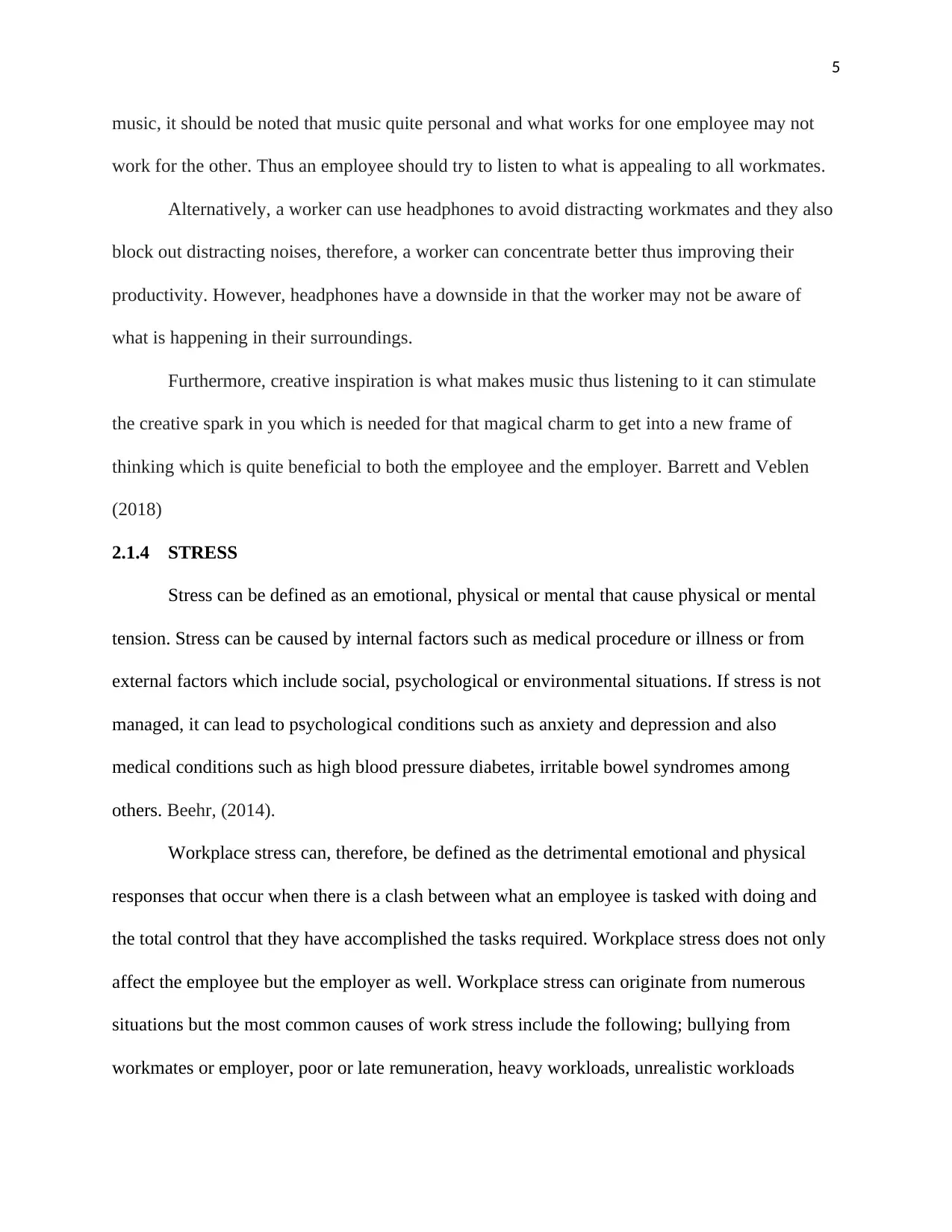
5
music, it should be noted that music quite personal and what works for one employee may not
work for the other. Thus an employee should try to listen to what is appealing to all workmates.
Alternatively, a worker can use headphones to avoid distracting workmates and they also
block out distracting noises, therefore, a worker can concentrate better thus improving their
productivity. However, headphones have a downside in that the worker may not be aware of
what is happening in their surroundings.
Furthermore, creative inspiration is what makes music thus listening to it can stimulate
the creative spark in you which is needed for that magical charm to get into a new frame of
thinking which is quite beneficial to both the employee and the employer. Barrett and Veblen
(2018)
2.1.4 STRESS
Stress can be defined as an emotional, physical or mental that cause physical or mental
tension. Stress can be caused by internal factors such as medical procedure or illness or from
external factors which include social, psychological or environmental situations. If stress is not
managed, it can lead to psychological conditions such as anxiety and depression and also
medical conditions such as high blood pressure diabetes, irritable bowel syndromes among
others. Beehr, (2014).
Workplace stress can, therefore, be defined as the detrimental emotional and physical
responses that occur when there is a clash between what an employee is tasked with doing and
the total control that they have accomplished the tasks required. Workplace stress does not only
affect the employee but the employer as well. Workplace stress can originate from numerous
situations but the most common causes of work stress include the following; bullying from
workmates or employer, poor or late remuneration, heavy workloads, unrealistic workloads
music, it should be noted that music quite personal and what works for one employee may not
work for the other. Thus an employee should try to listen to what is appealing to all workmates.
Alternatively, a worker can use headphones to avoid distracting workmates and they also
block out distracting noises, therefore, a worker can concentrate better thus improving their
productivity. However, headphones have a downside in that the worker may not be aware of
what is happening in their surroundings.
Furthermore, creative inspiration is what makes music thus listening to it can stimulate
the creative spark in you which is needed for that magical charm to get into a new frame of
thinking which is quite beneficial to both the employee and the employer. Barrett and Veblen
(2018)
2.1.4 STRESS
Stress can be defined as an emotional, physical or mental that cause physical or mental
tension. Stress can be caused by internal factors such as medical procedure or illness or from
external factors which include social, psychological or environmental situations. If stress is not
managed, it can lead to psychological conditions such as anxiety and depression and also
medical conditions such as high blood pressure diabetes, irritable bowel syndromes among
others. Beehr, (2014).
Workplace stress can, therefore, be defined as the detrimental emotional and physical
responses that occur when there is a clash between what an employee is tasked with doing and
the total control that they have accomplished the tasks required. Workplace stress does not only
affect the employee but the employer as well. Workplace stress can originate from numerous
situations but the most common causes of work stress include the following; bullying from
workmates or employer, poor or late remuneration, heavy workloads, unrealistic workloads
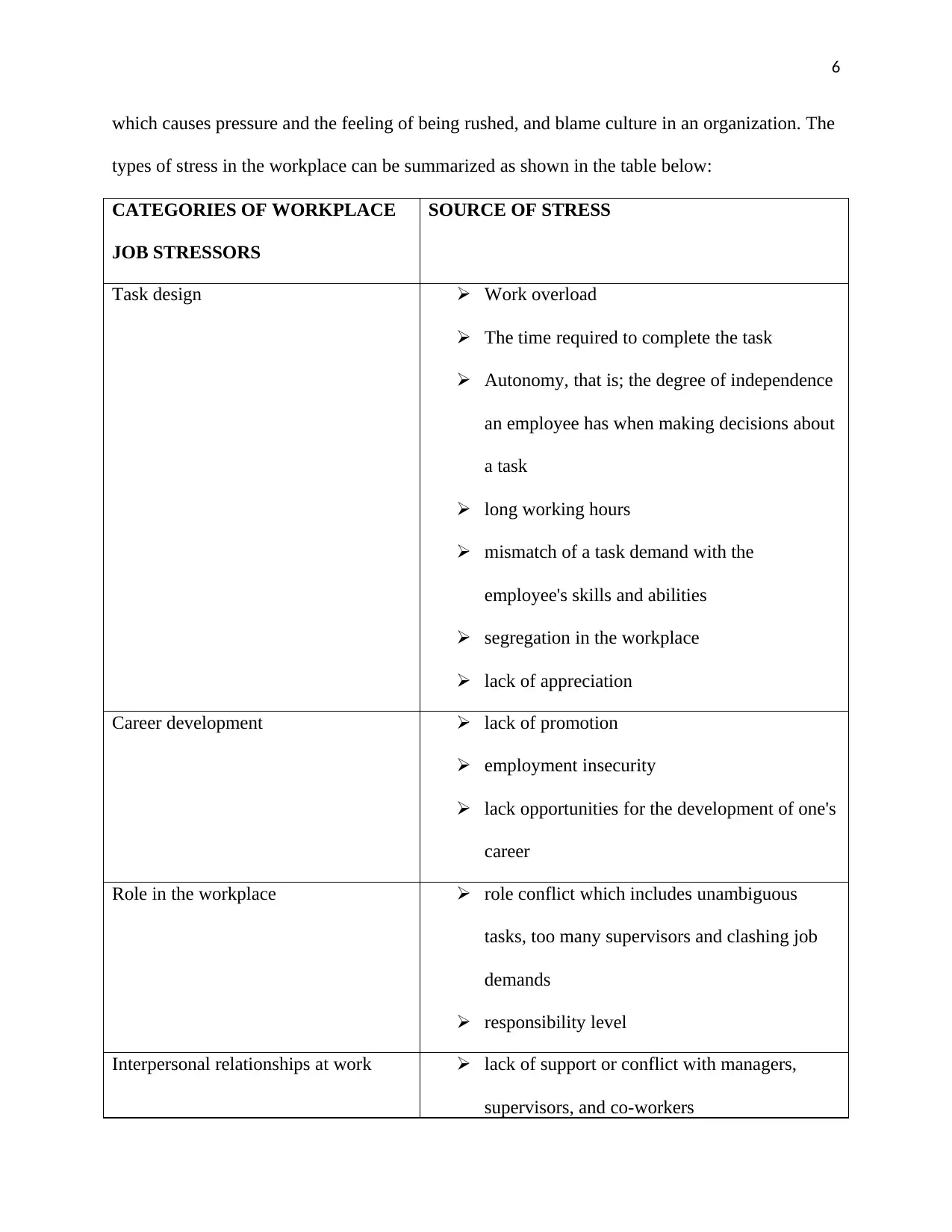
6
which causes pressure and the feeling of being rushed, and blame culture in an organization. The
types of stress in the workplace can be summarized as shown in the table below:
CATEGORIES OF WORKPLACE
JOB STRESSORS
SOURCE OF STRESS
Task design Work overload
The time required to complete the task
Autonomy, that is; the degree of independence
an employee has when making decisions about
a task
long working hours
mismatch of a task demand with the
employee's skills and abilities
segregation in the workplace
lack of appreciation
Career development lack of promotion
employment insecurity
lack opportunities for the development of one's
career
Role in the workplace role conflict which includes unambiguous
tasks, too many supervisors and clashing job
demands
responsibility level
Interpersonal relationships at work lack of support or conflict with managers,
supervisors, and co-workers
which causes pressure and the feeling of being rushed, and blame culture in an organization. The
types of stress in the workplace can be summarized as shown in the table below:
CATEGORIES OF WORKPLACE
JOB STRESSORS
SOURCE OF STRESS
Task design Work overload
The time required to complete the task
Autonomy, that is; the degree of independence
an employee has when making decisions about
a task
long working hours
mismatch of a task demand with the
employee's skills and abilities
segregation in the workplace
lack of appreciation
Career development lack of promotion
employment insecurity
lack opportunities for the development of one's
career
Role in the workplace role conflict which includes unambiguous
tasks, too many supervisors and clashing job
demands
responsibility level
Interpersonal relationships at work lack of support or conflict with managers,
supervisors, and co-workers
⊘ This is a preview!⊘
Do you want full access?
Subscribe today to unlock all pages.

Trusted by 1+ million students worldwide
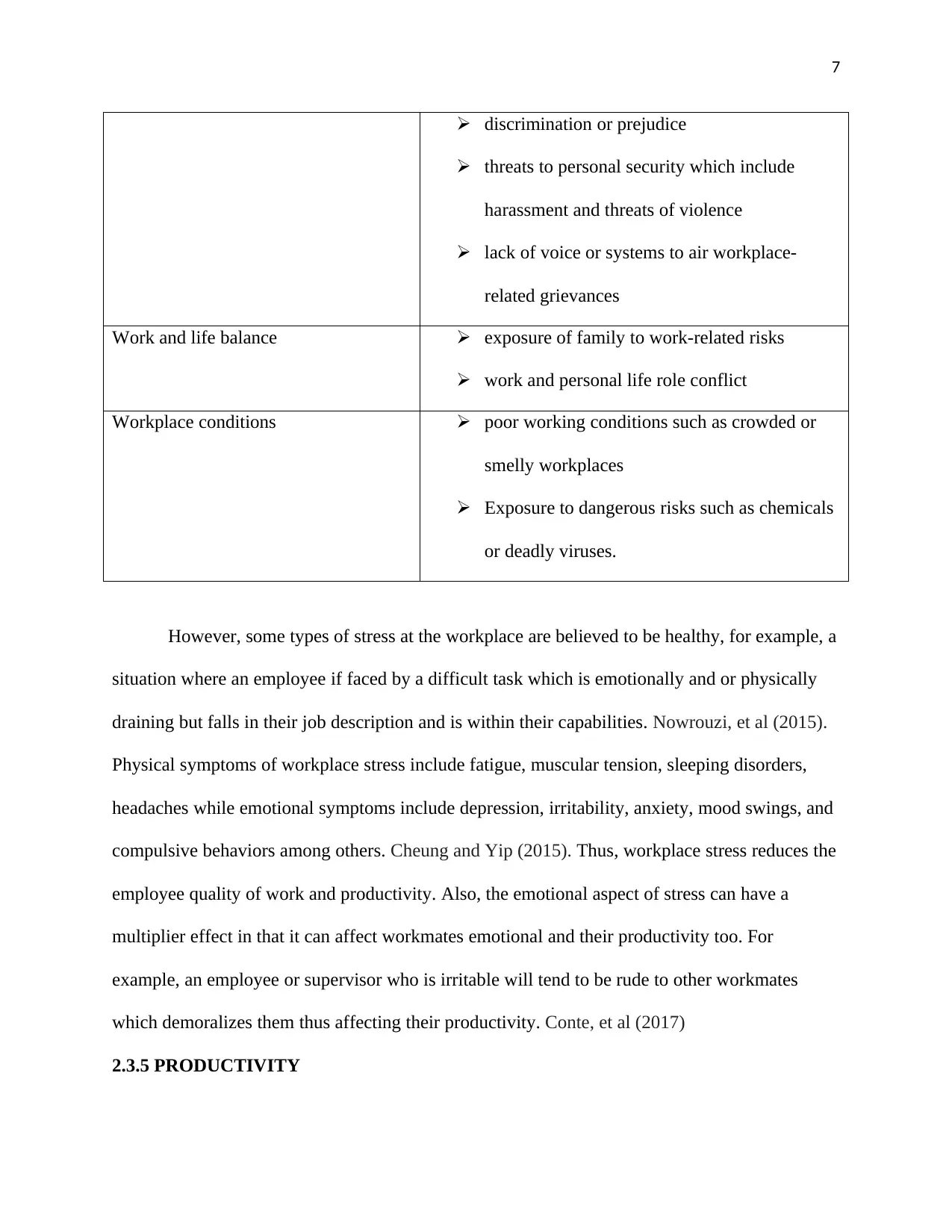
7
discrimination or prejudice
threats to personal security which include
harassment and threats of violence
lack of voice or systems to air workplace-
related grievances
Work and life balance exposure of family to work-related risks
work and personal life role conflict
Workplace conditions poor working conditions such as crowded or
smelly workplaces
Exposure to dangerous risks such as chemicals
or deadly viruses.
However, some types of stress at the workplace are believed to be healthy, for example, a
situation where an employee if faced by a difficult task which is emotionally and or physically
draining but falls in their job description and is within their capabilities. Nowrouzi, et al (2015).
Physical symptoms of workplace stress include fatigue, muscular tension, sleeping disorders,
headaches while emotional symptoms include depression, irritability, anxiety, mood swings, and
compulsive behaviors among others. Cheung and Yip (2015). Thus, workplace stress reduces the
employee quality of work and productivity. Also, the emotional aspect of stress can have a
multiplier effect in that it can affect workmates emotional and their productivity too. For
example, an employee or supervisor who is irritable will tend to be rude to other workmates
which demoralizes them thus affecting their productivity. Conte, et al (2017)
2.3.5 PRODUCTIVITY
discrimination or prejudice
threats to personal security which include
harassment and threats of violence
lack of voice or systems to air workplace-
related grievances
Work and life balance exposure of family to work-related risks
work and personal life role conflict
Workplace conditions poor working conditions such as crowded or
smelly workplaces
Exposure to dangerous risks such as chemicals
or deadly viruses.
However, some types of stress at the workplace are believed to be healthy, for example, a
situation where an employee if faced by a difficult task which is emotionally and or physically
draining but falls in their job description and is within their capabilities. Nowrouzi, et al (2015).
Physical symptoms of workplace stress include fatigue, muscular tension, sleeping disorders,
headaches while emotional symptoms include depression, irritability, anxiety, mood swings, and
compulsive behaviors among others. Cheung and Yip (2015). Thus, workplace stress reduces the
employee quality of work and productivity. Also, the emotional aspect of stress can have a
multiplier effect in that it can affect workmates emotional and their productivity too. For
example, an employee or supervisor who is irritable will tend to be rude to other workmates
which demoralizes them thus affecting their productivity. Conte, et al (2017)
2.3.5 PRODUCTIVITY
Paraphrase This Document
Need a fresh take? Get an instant paraphrase of this document with our AI Paraphraser
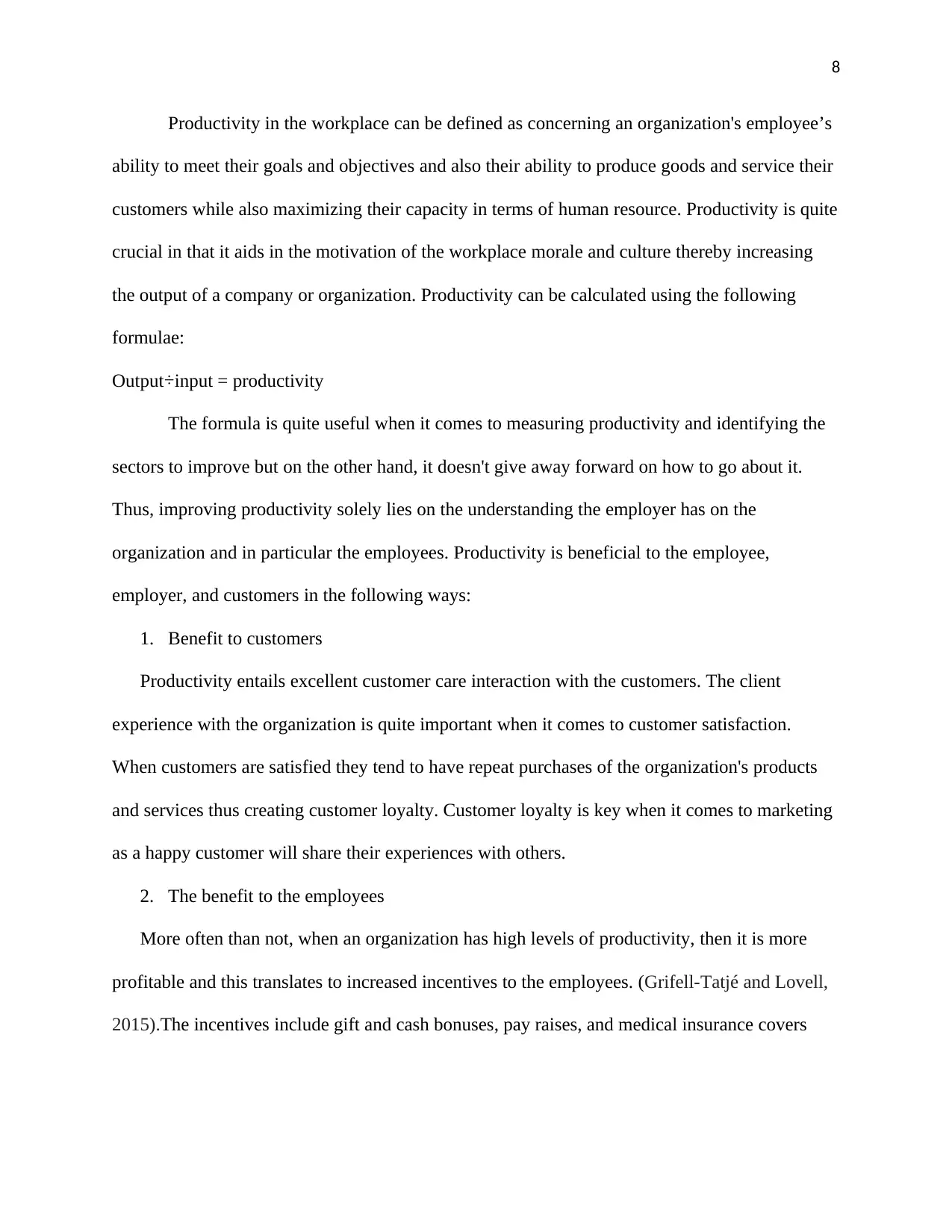
8
Productivity in the workplace can be defined as concerning an organization's employee’s
ability to meet their goals and objectives and also their ability to produce goods and service their
customers while also maximizing their capacity in terms of human resource. Productivity is quite
crucial in that it aids in the motivation of the workplace morale and culture thereby increasing
the output of a company or organization. Productivity can be calculated using the following
formulae:
Output ÷input = productivity
The formula is quite useful when it comes to measuring productivity and identifying the
sectors to improve but on the other hand, it doesn't give away forward on how to go about it.
Thus, improving productivity solely lies on the understanding the employer has on the
organization and in particular the employees. Productivity is beneficial to the employee,
employer, and customers in the following ways:
1. Benefit to customers
Productivity entails excellent customer care interaction with the customers. The client
experience with the organization is quite important when it comes to customer satisfaction.
When customers are satisfied they tend to have repeat purchases of the organization's products
and services thus creating customer loyalty. Customer loyalty is key when it comes to marketing
as a happy customer will share their experiences with others.
2. The benefit to the employees
More often than not, when an organization has high levels of productivity, then it is more
profitable and this translates to increased incentives to the employees. (Grifell-Tatjé and Lovell,
2015).The incentives include gift and cash bonuses, pay raises, and medical insurance covers
Productivity in the workplace can be defined as concerning an organization's employee’s
ability to meet their goals and objectives and also their ability to produce goods and service their
customers while also maximizing their capacity in terms of human resource. Productivity is quite
crucial in that it aids in the motivation of the workplace morale and culture thereby increasing
the output of a company or organization. Productivity can be calculated using the following
formulae:
Output ÷input = productivity
The formula is quite useful when it comes to measuring productivity and identifying the
sectors to improve but on the other hand, it doesn't give away forward on how to go about it.
Thus, improving productivity solely lies on the understanding the employer has on the
organization and in particular the employees. Productivity is beneficial to the employee,
employer, and customers in the following ways:
1. Benefit to customers
Productivity entails excellent customer care interaction with the customers. The client
experience with the organization is quite important when it comes to customer satisfaction.
When customers are satisfied they tend to have repeat purchases of the organization's products
and services thus creating customer loyalty. Customer loyalty is key when it comes to marketing
as a happy customer will share their experiences with others.
2. The benefit to the employees
More often than not, when an organization has high levels of productivity, then it is more
profitable and this translates to increased incentives to the employees. (Grifell-Tatjé and Lovell,
2015).The incentives include gift and cash bonuses, pay raises, and medical insurance covers
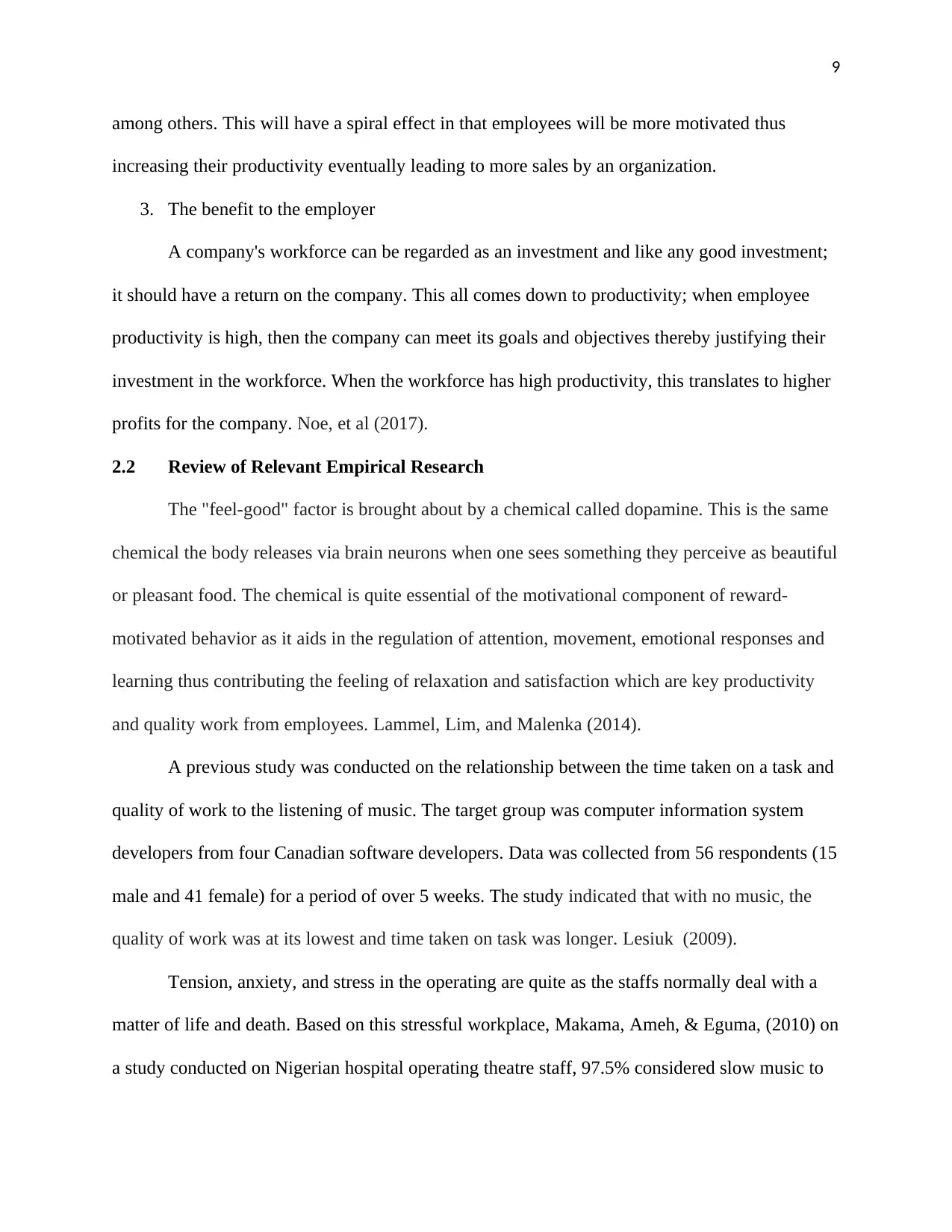
9
among others. This will have a spiral effect in that employees will be more motivated thus
increasing their productivity eventually leading to more sales by an organization.
3. The benefit to the employer
A company's workforce can be regarded as an investment and like any good investment;
it should have a return on the company. This all comes down to productivity; when employee
productivity is high, then the company can meet its goals and objectives thereby justifying their
investment in the workforce. When the workforce has high productivity, this translates to higher
profits for the company. Noe, et al (2017).
2.2 Review of Relevant Empirical Research
The "feel-good" factor is brought about by a chemical called dopamine. This is the same
chemical the body releases via brain neurons when one sees something they perceive as beautiful
or pleasant food. The chemical is quite essential of the motivational component of reward-
motivated behavior as it aids in the regulation of attention, movement, emotional responses and
learning thus contributing the feeling of relaxation and satisfaction which are key productivity
and quality work from employees. Lammel, Lim, and Malenka (2014).
A previous study was conducted on the relationship between the time taken on a task and
quality of work to the listening of music. The target group was computer information system
developers from four Canadian software developers. Data was collected from 56 respondents (15
male and 41 female) for a period of over 5 weeks. The study indicated that with no music, the
quality of work was at its lowest and time taken on task was longer. Lesiuk (2009).
Tension, anxiety, and stress in the operating are quite as the staffs normally deal with a
matter of life and death. Based on this stressful workplace, Makama, Ameh, & Eguma, (2010) on
a study conducted on Nigerian hospital operating theatre staff, 97.5% considered slow music to
among others. This will have a spiral effect in that employees will be more motivated thus
increasing their productivity eventually leading to more sales by an organization.
3. The benefit to the employer
A company's workforce can be regarded as an investment and like any good investment;
it should have a return on the company. This all comes down to productivity; when employee
productivity is high, then the company can meet its goals and objectives thereby justifying their
investment in the workforce. When the workforce has high productivity, this translates to higher
profits for the company. Noe, et al (2017).
2.2 Review of Relevant Empirical Research
The "feel-good" factor is brought about by a chemical called dopamine. This is the same
chemical the body releases via brain neurons when one sees something they perceive as beautiful
or pleasant food. The chemical is quite essential of the motivational component of reward-
motivated behavior as it aids in the regulation of attention, movement, emotional responses and
learning thus contributing the feeling of relaxation and satisfaction which are key productivity
and quality work from employees. Lammel, Lim, and Malenka (2014).
A previous study was conducted on the relationship between the time taken on a task and
quality of work to the listening of music. The target group was computer information system
developers from four Canadian software developers. Data was collected from 56 respondents (15
male and 41 female) for a period of over 5 weeks. The study indicated that with no music, the
quality of work was at its lowest and time taken on task was longer. Lesiuk (2009).
Tension, anxiety, and stress in the operating are quite as the staffs normally deal with a
matter of life and death. Based on this stressful workplace, Makama, Ameh, & Eguma, (2010) on
a study conducted on Nigerian hospital operating theatre staff, 97.5% considered slow music to
⊘ This is a preview!⊘
Do you want full access?
Subscribe today to unlock all pages.

Trusted by 1+ million students worldwide
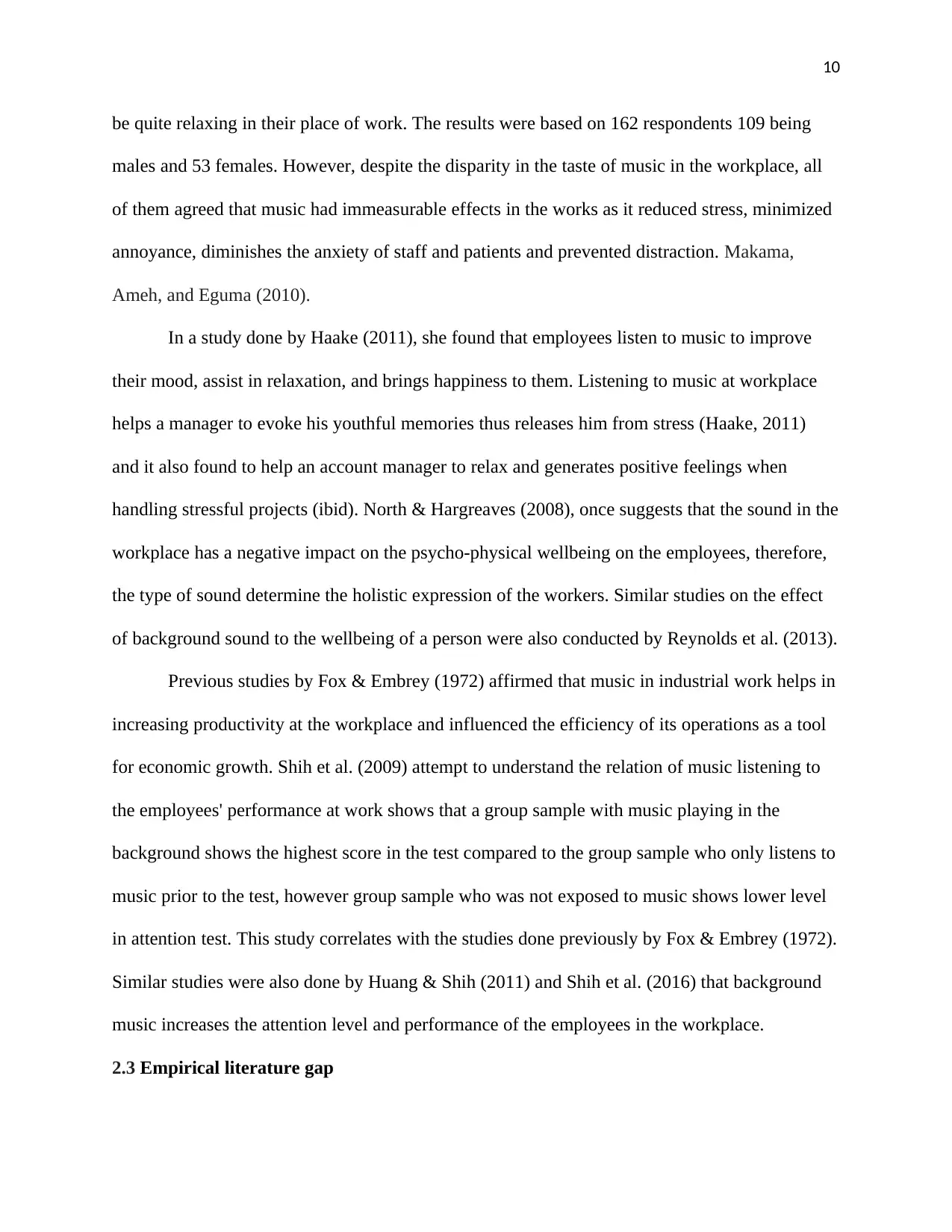
10
be quite relaxing in their place of work. The results were based on 162 respondents 109 being
males and 53 females. However, despite the disparity in the taste of music in the workplace, all
of them agreed that music had immeasurable effects in the works as it reduced stress, minimized
annoyance, diminishes the anxiety of staff and patients and prevented distraction. Makama,
Ameh, and Eguma (2010).
In a study done by Haake (2011), she found that employees listen to music to improve
their mood, assist in relaxation, and brings happiness to them. Listening to music at workplace
helps a manager to evoke his youthful memories thus releases him from stress (Haake, 2011)
and it also found to help an account manager to relax and generates positive feelings when
handling stressful projects (ibid). North & Hargreaves (2008), once suggests that the sound in the
workplace has a negative impact on the psycho-physical wellbeing on the employees, therefore,
the type of sound determine the holistic expression of the workers. Similar studies on the effect
of background sound to the wellbeing of a person were also conducted by Reynolds et al. (2013).
Previous studies by Fox & Embrey (1972) affirmed that music in industrial work helps in
increasing productivity at the workplace and influenced the efficiency of its operations as a tool
for economic growth. Shih et al. (2009) attempt to understand the relation of music listening to
the employees' performance at work shows that a group sample with music playing in the
background shows the highest score in the test compared to the group sample who only listens to
music prior to the test, however group sample who was not exposed to music shows lower level
in attention test. This study correlates with the studies done previously by Fox & Embrey (1972).
Similar studies were also done by Huang & Shih (2011) and Shih et al. (2016) that background
music increases the attention level and performance of the employees in the workplace.
2.3 Empirical literature gap
be quite relaxing in their place of work. The results were based on 162 respondents 109 being
males and 53 females. However, despite the disparity in the taste of music in the workplace, all
of them agreed that music had immeasurable effects in the works as it reduced stress, minimized
annoyance, diminishes the anxiety of staff and patients and prevented distraction. Makama,
Ameh, and Eguma (2010).
In a study done by Haake (2011), she found that employees listen to music to improve
their mood, assist in relaxation, and brings happiness to them. Listening to music at workplace
helps a manager to evoke his youthful memories thus releases him from stress (Haake, 2011)
and it also found to help an account manager to relax and generates positive feelings when
handling stressful projects (ibid). North & Hargreaves (2008), once suggests that the sound in the
workplace has a negative impact on the psycho-physical wellbeing on the employees, therefore,
the type of sound determine the holistic expression of the workers. Similar studies on the effect
of background sound to the wellbeing of a person were also conducted by Reynolds et al. (2013).
Previous studies by Fox & Embrey (1972) affirmed that music in industrial work helps in
increasing productivity at the workplace and influenced the efficiency of its operations as a tool
for economic growth. Shih et al. (2009) attempt to understand the relation of music listening to
the employees' performance at work shows that a group sample with music playing in the
background shows the highest score in the test compared to the group sample who only listens to
music prior to the test, however group sample who was not exposed to music shows lower level
in attention test. This study correlates with the studies done previously by Fox & Embrey (1972).
Similar studies were also done by Huang & Shih (2011) and Shih et al. (2016) that background
music increases the attention level and performance of the employees in the workplace.
2.3 Empirical literature gap
Paraphrase This Document
Need a fresh take? Get an instant paraphrase of this document with our AI Paraphraser
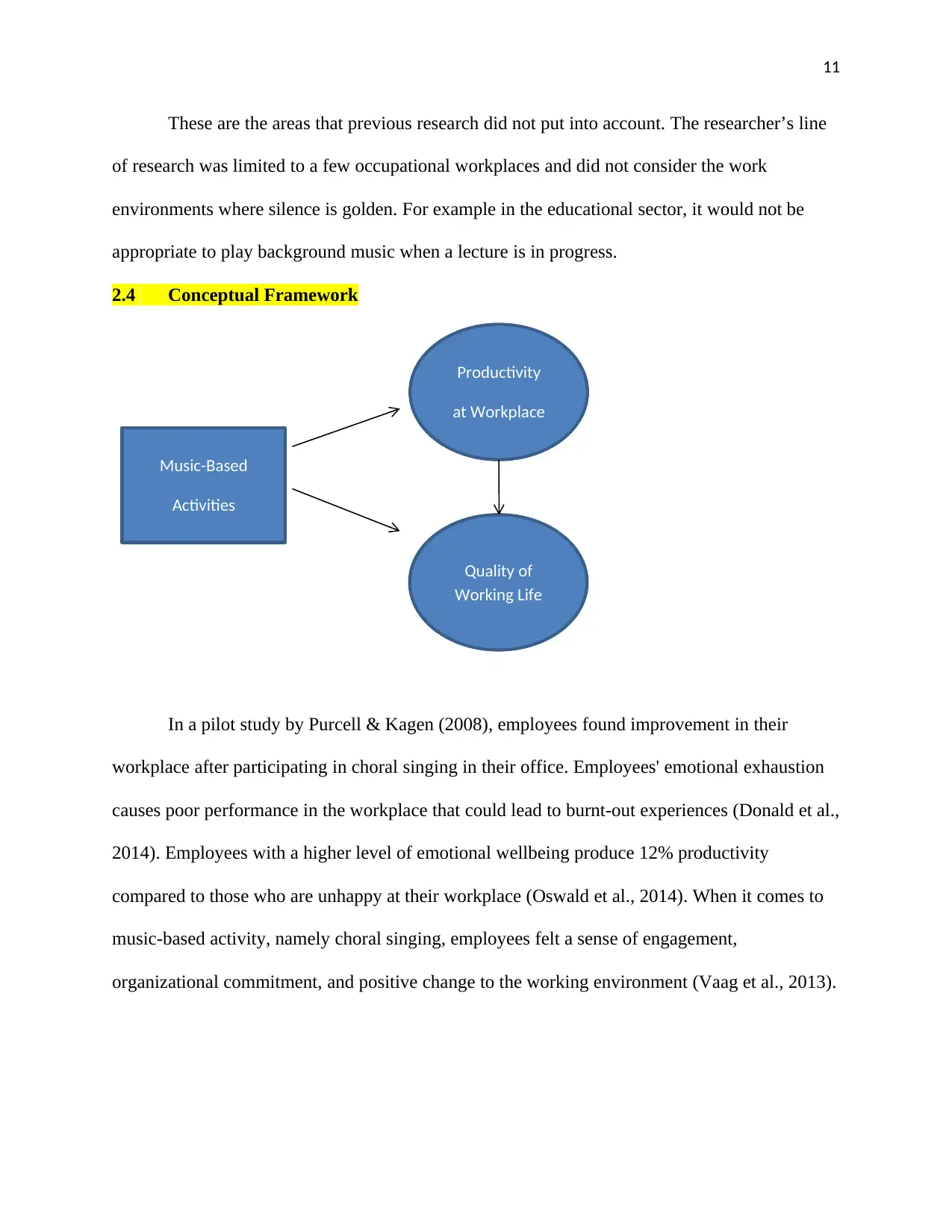
11
These are the areas that previous research did not put into account. The researcher’s line
of research was limited to a few occupational workplaces and did not consider the work
environments where silence is golden. For example in the educational sector, it would not be
appropriate to play background music when a lecture is in progress.
2.4 Conceptual Framework
In a pilot study by Purcell & Kagen (2008), employees found improvement in their
workplace after participating in choral singing in their office. Employees' emotional exhaustion
causes poor performance in the workplace that could lead to burnt-out experiences (Donald et al.,
2014). Employees with a higher level of emotional wellbeing produce 12% productivity
compared to those who are unhappy at their workplace (Oswald et al., 2014). When it comes to
music-based activity, namely choral singing, employees felt a sense of engagement,
organizational commitment, and positive change to the working environment (Vaag et al., 2013).
Music-Based
Activities
Productivity
at Workplace
Quality of
Working Life
These are the areas that previous research did not put into account. The researcher’s line
of research was limited to a few occupational workplaces and did not consider the work
environments where silence is golden. For example in the educational sector, it would not be
appropriate to play background music when a lecture is in progress.
2.4 Conceptual Framework
In a pilot study by Purcell & Kagen (2008), employees found improvement in their
workplace after participating in choral singing in their office. Employees' emotional exhaustion
causes poor performance in the workplace that could lead to burnt-out experiences (Donald et al.,
2014). Employees with a higher level of emotional wellbeing produce 12% productivity
compared to those who are unhappy at their workplace (Oswald et al., 2014). When it comes to
music-based activity, namely choral singing, employees felt a sense of engagement,
organizational commitment, and positive change to the working environment (Vaag et al., 2013).
Music-Based
Activities
Productivity
at Workplace
Quality of
Working Life
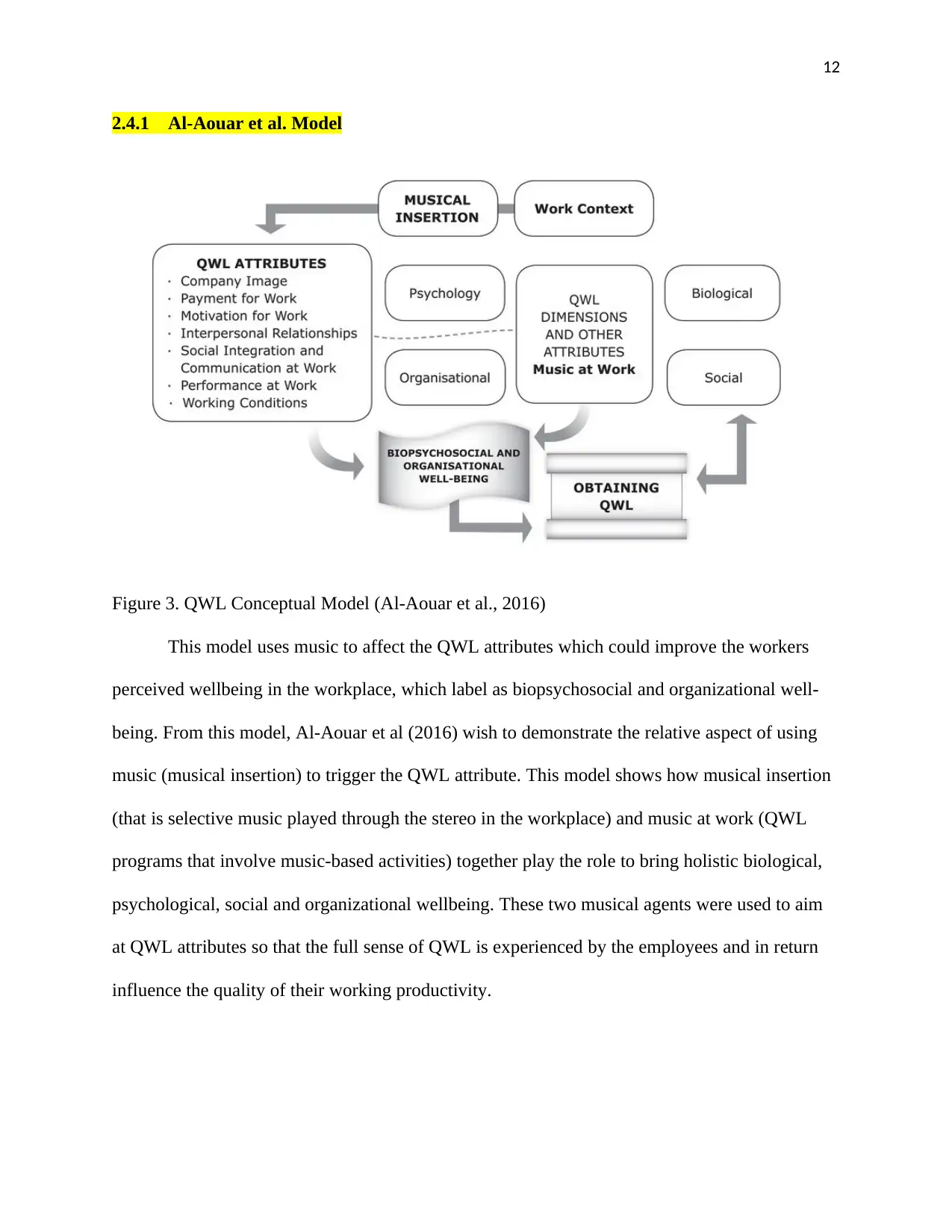
12
2.4.1 Al-Aouar et al. Model
Figure 3. QWL Conceptual Model (Al-Aouar et al., 2016)
This model uses music to affect the QWL attributes which could improve the workers
perceived wellbeing in the workplace, which label as biopsychosocial and organizational well-
being. From this model, Al-Aouar et al (2016) wish to demonstrate the relative aspect of using
music (musical insertion) to trigger the QWL attribute. This model shows how musical insertion
(that is selective music played through the stereo in the workplace) and music at work (QWL
programs that involve music-based activities) together play the role to bring holistic biological,
psychological, social and organizational wellbeing. These two musical agents were used to aim
at QWL attributes so that the full sense of QWL is experienced by the employees and in return
influence the quality of their working productivity.
2.4.1 Al-Aouar et al. Model
Figure 3. QWL Conceptual Model (Al-Aouar et al., 2016)
This model uses music to affect the QWL attributes which could improve the workers
perceived wellbeing in the workplace, which label as biopsychosocial and organizational well-
being. From this model, Al-Aouar et al (2016) wish to demonstrate the relative aspect of using
music (musical insertion) to trigger the QWL attribute. This model shows how musical insertion
(that is selective music played through the stereo in the workplace) and music at work (QWL
programs that involve music-based activities) together play the role to bring holistic biological,
psychological, social and organizational wellbeing. These two musical agents were used to aim
at QWL attributes so that the full sense of QWL is experienced by the employees and in return
influence the quality of their working productivity.
⊘ This is a preview!⊘
Do you want full access?
Subscribe today to unlock all pages.

Trusted by 1+ million students worldwide
1 out of 17
Related Documents
Your All-in-One AI-Powered Toolkit for Academic Success.
+13062052269
info@desklib.com
Available 24*7 on WhatsApp / Email
![[object Object]](/_next/static/media/star-bottom.7253800d.svg)
Unlock your academic potential
Copyright © 2020–2025 A2Z Services. All Rights Reserved. Developed and managed by ZUCOL.





